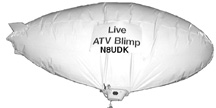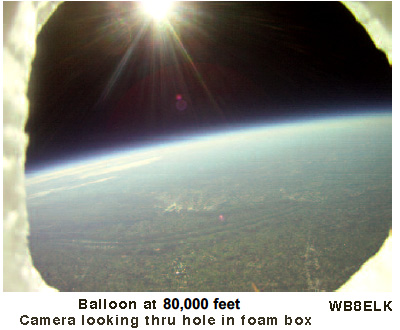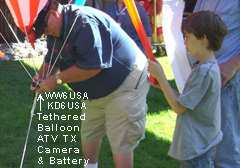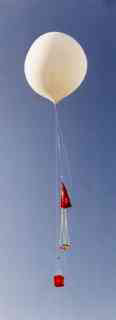 ATV Antennas in Amateur Rockets and Balloons - App Note
ATV Antennas in Amateur Rockets and Balloons - App Note
Rockets, Balloons or transmitting from any type of vehicle over head presents unique antenna problems for getting the best picture over the farthest distance on the horizon or at the launch site below.
The type and placing of antennas in the vehicle and on the ground are discussed. Construction of a Turnstyle circular polarized antenna for launch site reception is described as well as making a reflector for the popular W6OAL Wheel horizontal omni antenna.
We suggest our TXA5-RC series 1Watt transmitter board or Videolynx VM70X transmitter module for most rocket and balloon applications.
See WC6P's video from a 7.5 inch dia rocket using one.
Check out KD7JVF's video from his rocket glider.
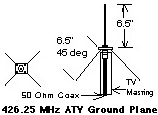 Homebrew Antennas - low cost and easy to make
Homebrew Antennas - low cost and easy to make
The Quagi antenna by Wayne N6NB is made from 12 gage copper TW house wire and wooden boom - 8 and 15 element beams for 70 and 23cm ATV. Another cheap and easy beam to build is by Kent WA5VJB. It is not as broad banded as the Quagi but fine if you prune it for your specific ATV frequency. Many bands and element lengths are shown.
A simple omni directional vertical antenna for demo's, R/C receive, etc., is the ground plane antenna made with just a connector and some wire.
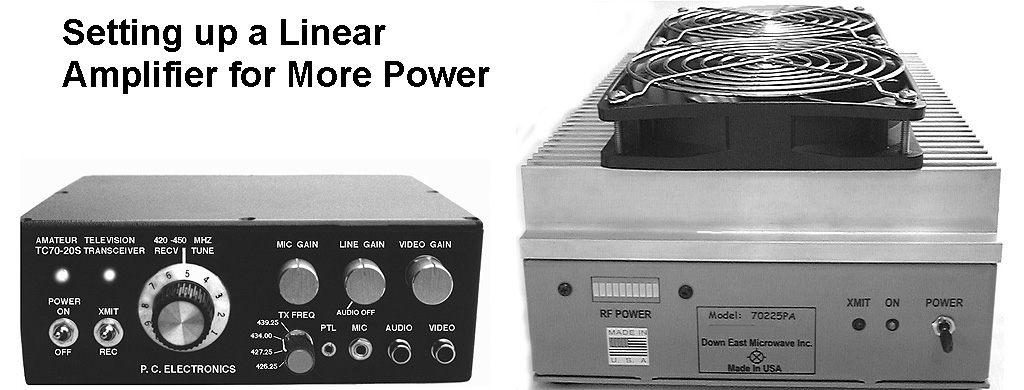 AM ATV LINEAR AMPLIFIER SETUP - App Note
AM ATV LINEAR AMPLIFIER SETUP - App Note The blanking pedestal in the ATV transmitters video modulator must be set to restore the video to sync ratio in Amateur linear amps to compensate for the gain compression which occurs typically between 1/2 to full rated peak envelope power rating of the amp. This app note gives you the procedure, why's and where fores. Average reading vs. Peak Envelope Power (PEP) RF meter readings are discussed.
You can download more specific information on the 70cm Mirage D1010 / D100, D26N, RF Concepts/Kantronics RFC4-110 and Teletec DXP-U150 Amplifiers which describes the ATV version of these 70cm 150, 100 and 50 Watt amps, and what is done to make them ATV compatible.
You can also down load our notes on driving the Downeast Microwave 7025PA 35 Watt 70cm, 70225PA 225 Watt 70cm and 2330PA 30 Watt 23cm amplifiers, also our PA5 board using the RA30H4047M RF power module for 25W on 70cm.
Packaging the Videolynx VM-70X 5
Watt transmitter module - App Note
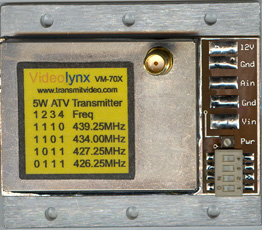
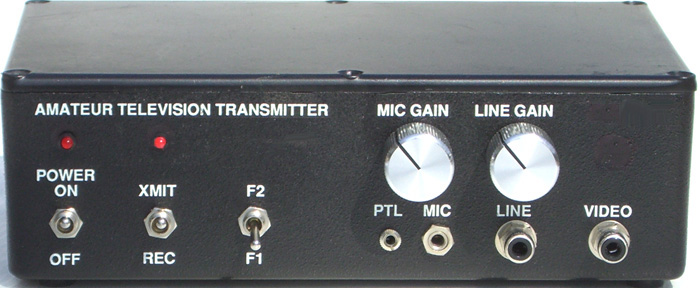
The Videolynx VM-70X is a compact transmitter module that accepts line level audio and video, 11 to 14Vdc and has adjustable RF output from 0 to 5 Watts on 4 digiswitch selectalbe frequencies - 426.25, 427.25, 434.0 and 439.25 MHz. This app note describes adding a computer fan for R/C, robot, rocket or balloon applications and also for home or portable use, packaging the VM-70X along with the TR-1b T/R relay boards in a Hammond 1590D (7.4x4.7x2.1") diecast aluminum box. Estimated cost of all parts is about $300 in the App Note parts list on page 3.
ATV Repeater System Design - App Note

A must read before you start building an ATV Repeater including sample priced out parts list and sources depending whether you want to go inband or crossband, which band or bands you want to use, single broadband or multiband or 2 antennas, horizontal or vertical, etc.
Inband ATV repeater example and parts list.
Crossband ATV repeater example and parts list.
Compare the attenuation curves of using an 8 pole or 10 pole VSB Filter especially on a 421.25 MHz repeater output.
To figure the ATV repeater coverage area, click on ATV DX which is on our home page.
Video Operated Relay - App Note
The VOR-3 board has many uses - simple ATV repeater controller, beacon timer, 10 minute ID timer, video squelch, link vs. local priority switch, repeater voting, etc.
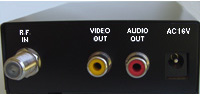 Channel 3 TV receiver module modifications for ATV
- App Note
Channel 3 TV receiver module modifications for ATV
- App Note
The Rch3 receiver - MCM Electronics Model 33-2060 - gives you a video and line audio output when connected to one of our 70cm downconverters like the TVC-4S. Great for seeing ATV on a camcorder monitor or DVD player screen when mobile or portable. The unit comes with a wall plug power supply for AC operation but this app note shows how to modify the receiver 16Vac input for 12 to 14 vdc input, add squelch and an S-meter.
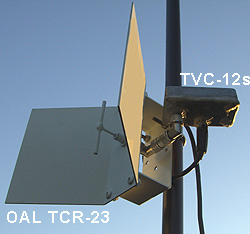 Antenna Mounting ATV Downconverters - App Note
Antenna Mounting ATV Downconverters - App Note
How to repackage a downconverter and the pluses and minuses of doing so vs. an antenna mounted preamp to eliminate the loss from long coax runs for optimum receive DX. For antenna mounted preamps you can make a bias T to power up the coax.
Variable Tuning the TVC-xS Downconverters - App Note
This app note describes how to add variable tuning to the synthesized TVCX-xS series of ATV downconverter boards used in our TVC-4S, 9S and 12S downconverters to enable tuning non-standard ATV frequencies in the band or fine tuning for sync bars in the noise when looking for DX.
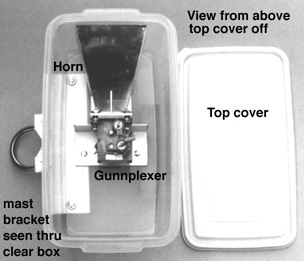 Gunnplexer ATV - App Note
Gunnplexer ATV - App Note
10 gHz Gunnplexer ATV transmitting system construction using the GVM-1 video modulator board. Wideband FM video modulation is used along with 6.2 and/or 6.8 MHz sound so that C band satellite TV receivers can be used along with a LNB made for 10.4 GHz. Gunnplexers are available from SHF Microwave and Advanced Receiver Research. Choose those that have varicap tuning diodes in them - the modulator connects to the varicap to FM modulate the Gunn diode in the Gunnplexer.
70cm Band Planning - App Note 434.0 vs 439.25 MHz LVSB technical considerations when FM voice repeaters expand below 444.0 MHz and coming up with an all mode local 70cm band plan. Lots of good information for frequency coordinators, repeater owners and any mode experiencing interference in the 70cm band because there is no sound technical band plan in place. Basically there is plenty of room in the 420-450 MHz band for FM voice repeaters and links, 2 ATV channels, weak signal, satellite and digital modes if a technical band plan is devised and agreed to by the areas hams.
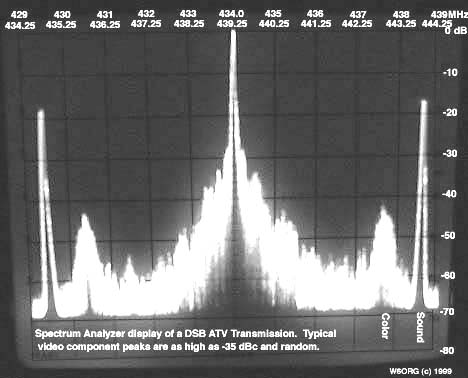 AM ATV DSB vs. VSB - App Note
AM ATV DSB vs. VSB - App Note
Describes the characteristics of transmitting AM video with double sidebands and vestigial sidebands, difficulty of maintaining VSB when driving amateur amps, and interference potential to other mode users.
ATV Emission Characteristics - App NoteA bunch of technical stuff including ATV emission bandwidth, channel spacing, sharing with other modes, and more.
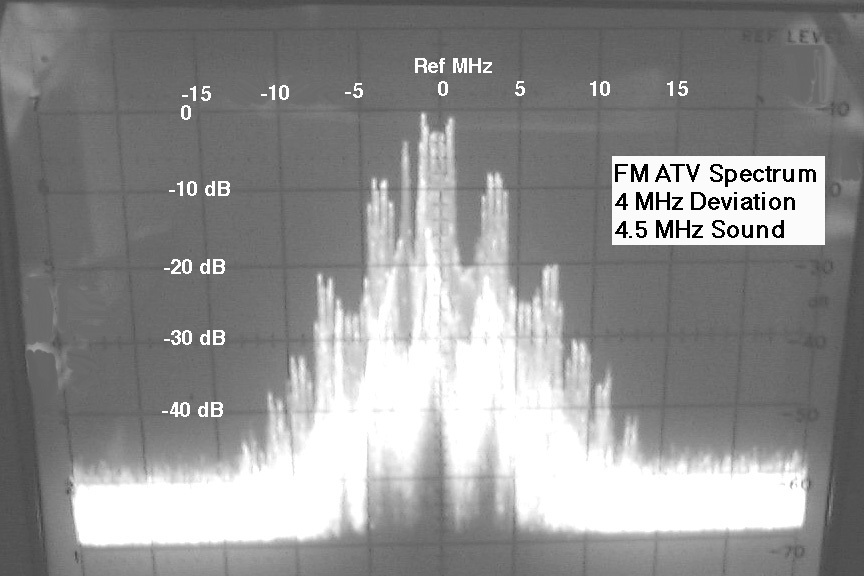 FM ATV - App Note
FM ATV - App Note Discusses differences between AM and FM transmission of ATV: DX, common frequencies, resolution, pre-emphasis / de-emphasis networks, etc. The ARRL 23cm bandplan does not have FM ATV. Here is a modified 23cm band plan that includes FM ATV.
 Crystals
Got an old transmitter or downconverter that you think the crystal went bad? Before you order a new rock, check out these trouble shooting tips. Also see our list of surplus crystals for $5 and sources for new crystals.
Crystals
Got an old transmitter or downconverter that you think the crystal went bad? Before you order a new rock, check out these trouble shooting tips. Also see our list of surplus crystals for $5 and sources for new crystals.
Ten pin VHS camera connector pin outs and connector source.
DC power connector pinouts and source for P. C. Electronics transceivers and transmitters.
Lamp replacement sources for P. C. Electronics Transceiver and Downconverters.
Manuals and Data Sheets on P. C. Electronics manufactured products are available by email request free only to licensed hams upon email request - include your call letters -  model number with revision letter or year as etched on the board. Please request only 1 or 2 at a time. model number with revision letter or year as etched on the board. Please request only 1 or 2 at a time.
Other ATV Info Sources:
ARRL Radio Amateurs Handbook The best discussion of ATV starts in chapter 9,12 or 32 in older books, and in the Image Communications section of the Downloadable Suppliment or CD that comes with the 2014 book and beyond. This is the Radio Amateurs bible for all the many facets of the hobby. The ARRL Operating Manual also has a good section on Image Communications including ATV.
Ham Nation is a weekly internet show with many different amateur radio topics including ATV - see episode 12 starting around minute 21.
Other ATV group web pages to check out:
Southern California ATV Repeater Map (updated Oct. 2024). In southern California, we suggest first getting a downconverter and antenna for the repeater ham band you are line of sight to and then seeing if you want to transmit later. You can talk back to the ATV transmitting stations on 146.430 (100.0 Hz) FM voice simplex. EmComm and public service groups use 426.25 MHz ATV simplex.

The So. Calif. Microwave Experimentors net is on Monday nights 7:30 PM utilizing a 10 gHz to 3.3 gHz ATV repeater system on two mountain tops - Santiago and Heaps Peak with tower cam ID's. Also there is info on R/C and Rocket ATV. The San Bernardino Microwave Society (SBMS) meetings are televised by W6KVC on the 1st Thursdays of the month starting at 7pm and can be seen on most So. Calif. ATV repeaters.

The ATN Amateur Television Network Net is on Tuesdays 7:30 PM. ATN has linked repeaters between the Los Angeles/ Orange/ San Bernardino/ Riverside County areas to Las Vegas, Santa Barbara and San Diego with the hub on Santiago Peak. Use 100.0 Hz CTCSS on 146.430 simplex to talk back through the Santiago Peak ATV repeater sound subcarrier output. W6ATV Rpt live stream
Santa Barbara CA
- WB9KMO, ATV special interest group of the Santa Barbara Amateur Radio Club. camstream
Mt. Diablo ARC - W6CX San Francisco Bay and Sacramento CA area. W6CX BATC - Streaming Media
Net Thurs. 8PM 147.06+ "If you are not on ATV, you are not getting the picture!"
Silicon Valley ATV Group - W6SVA, Loma Prieta, San Jose CA area
Redding CA
- WR6TV Mt. Shasta ATV repeater
Arizona Amateur Television Network - W7ATN: UseryMtn. (Mesa), White Tanks (West Phoenix Valley), Mt. Lemmon (Tucson)
Phoenix AZ AATV Group - W7ATV, Shaw Butte
Portland, Oregon ATV Assn. - WA7DRO.
Salem Oregon ATV Assn. - K7ATV
Western Washington State ATV Society - WW7ATS, Puget Sound area
Idaho - K6ZVA Mt. Harrison Repeater
Boulder, Colorado - BARC uses 146.70 repeater for talk back, KH6HTV's Repeater Directory.
Detroit Michigan ATV group - DATS, N8UDK ATV repeater, R/C ATV in Blimp, Cars & Planes; Rocket & Helmet Cam
Florida, Cocoa Beach, LISATS - K4ATV, Launch Information Service & Amateur Television System, Kennedy Space Center
Atlanta Georgia, Big Shanty Repeater Group
Durham North Carolina -NC4TV, Triangle ATV Association
CATS - Chesapeake Amateur Television Society, Laurel MD - Live Stream.
BRATS
- W3WCQ, Baltimore MD ATV Society, NE Baltimore
Ohio ATV group - ATCO, WR8ATV, Columbus, 1st DTV ATV repeater in the USA. Repeater live stream
Waco TX ATV Society - W5ZDN, now part of Heart O'Texas ARC.
Houston TX ATV - KC5LCP
Kansas City ATV - WR0ATV
Southern Illinois ATV Group - SILATVG - main focus is simplex ATV DX, great Tropo DX Skip forcast map on their link list.
Minnesota ATV Group - MNFAT ATV - N0MNB.
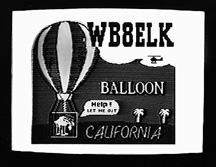 Bill Brown, WB8ELK's ATV Balloon web site Live stream
Bill Brown, WB8ELK's ATV Balloon web site Live stream
British ATV Club
Manufacturers and dealers of ATV related equipment that we maintain a *web page for or recommend:
*Intuitive Circuits - OSD Video ID overlay, ATV repeater
controller & DTMF relay boards
*Videolynx - 50mW & 5W 70cm AM ATV transmitter modules
KH6HTV Video - wide range of ATV gear and app notes, especially on DVB-T.
Hi-Des - DVB-T modulators and receivers
DATV-Express - Fully assembled digital ATV exciter board. 100-2450 MHz.
ATV Research - a great low cost source for small cameras
and accessories
Arrow Antenna - Antennas
Directive Systems - Antennas and feeds
Downeast Microwave - Amps and Preamps
W6PQL - Linear amps and more.
SHF Microwave - 10 gHz Gunnplexer source for ATV
RF Parts - Diamond Antennas, replacement RF semiconductors and power modules
DCI - VSB and bandpass filters
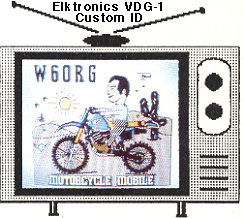 Elktronics - Custom color video ID and grpahics VDG-1 generator board example at right. Elktronics - Custom color video ID and grpahics VDG-1 generator board example at right.
Hamcity - Store with all the major ham radio
equipment brands in Culver City CA
Ham Radio Outlet - Major ham radio equipment dealer with
many stores around the country.
Mouser Electronics - Big Catalogue of new Electronic Parts
Digikey - Big Catalogue of new Electronic Parts
Jameco - Big Catalogue of surplus and new Electronic Parts
Marlin P. Jones - Big Catalogue of surplus and new Electronic Parts
Other Ham Radio resources:
SSTV - KB4YZ's complete list of all things Slow Scan. SSTV allows still frame pictures over
any voice mode channel.
Ham Radio Online
WA7RHK's Galaxy - over 300 ham manufacturers, dealers, and organizations
DXzone - listing of Ham Radio links
Open repeater listings - VHF&UHF in the USA
QRZ Call sign lookup and Ham Radio Super Site
Getting a ham license
You too can enjoy ATV and the many modes of radio communications open to you with an Amateur Radio license by first taking the FCC test for the code-free Technician Class Amateur Radio License. The entry level Technician Class FCC Amateur Radio license is all you need. A ham license is good for 10 years and is renewable on line at no cost or retest. There are 35 multiple choice questions from a pool of 429 of which you can miss no more than 7 to pass and learning morse code is no longer required. Cost of the initial test is about $10.
The easiest, and takes the least time, is an one day class and test that is given 4 times a year - mid January, April, July and October - from 9am to 4pm on Sundays. Location is at the Agoura Hills Calabasas Community Center, 27040 Malibu Hills Road
Calabasas, CA 91301, however, during the pandemic, they are doing it on Zoom. Cost is $75 and requires some pre-study. They use the "read only the right answers" method for passing a multiple guess type of test and have a 97% pass rate. After you get your license, you can learn what you need for the kind of operating you want to do. They have follow on classes.
You can self study the right questions only method in your own time, then take the exam on line for $10. HamStudy has a study class for about $30 and they suggest averaging 1 hr per day for two weeks. If you prefer reading from a book rather than on the computer, you can get the Easy Way Tech class ham study book. Another on line study course is Ham Radio Prep - try it free for 5 minutes. The Gordon West Radio School has a variety of study books and tapes.
It is important for hams to keep the FCC license data base current with your mailing address. If the FCC should happen to send you a piece of mail and it bounces back to them, they can revoke your license per 97.23. It has been estimated that about 20% of the addresses in the Callbook have changed. I have noted about the same when checking mailing addresses vs the Callbook. I dont think anyone would want to find upon renewal that their license was revoked and have to take the test over again.
The easiest way to check, renew or update your license is on the QRZ/W5YI VEC web site.
Legal Uses of Amateur Radio and FCC Rules
Amateur Radio and Television is legal only for non-commercial communications between licensed ham operators - FCC Rule 97.1. The purpose of Amateur Radio is a hobby that promotes the advancement of the radio art, international goodwill but most importantly, emergency communications. There are many fun applications of the ATV mode of this hobby which are described elsewhere scrolling on this page and on the home page.
The FCC (Federal Communications Commission) regulates the use of the radio frequency spectrum so that communication services do not interfere with each other. FCC Rules, 47 CFR 97.111 and 97.113, prohibits Amateur Radio Service bands to be used, with very few exceptions, for one way transmissions or to further any business purpose - profit or non-profit - no broadcasting, news gathering, local cable access link, teaching aid for unrelated subjects, retransmitting any other service or music, private, home or business surveillance, or regular business of police, fire or government agencies except as allowed for occasional emergency preparedness drills operated by licensed hams or under FCC Rules 47 CFR part 97.407. The FCC recently defined a change to 97.113 that allows training for emergency communications using amateur radio by businesses such as hospitals and others in specific instances. State and local emergency service groups can operate under 97.407, Radio Amateur Civil Emergency Service, if they follow the outline as described by FEMA. Hams must identify their transmissions with their call letters at least every 10 minutes and at the end of a transmission - 97.119. One way transmission on Ham radio frequencies can be used for Radio Control vehicles without IDing and with some restrictions per 97.215. Penalties are up to $10,000 per day of illegal operation and 6 months in jail.
For a complete list of all the Amateur Radio Service FCC Rules go to: FCC Part 97
License Free Part 15 and Business/Public Safety Part 90 Applications
For short distance line of sight non-amateur video link applications up to 1000 feet, we suggest the legal Part 15 FCC Compliant license free wireless audio/video send and receive systems offered by Radio Shack (15-126) and others in the 902-928 MHz and 2.4 gHz bands. A transmitter and receiver system is typically about $100. Only the legal license free devices will all have an FCC ID sticker somewhere on them - any RF device that doesn't, and claims to be license free, probably is not legal. You are free to transmit audio and video for any purpose, business or personal at any time and for as long as you like. The key to getting the best distance is to position the attached antennas to point at each other and to have line of sight between them. The pop up paddle type of antennas often used on the Radio Shack or Wavecom wireless transmitters and receivers are somewhat directional perpendicular to their surface. One just has to move each end around to find the best spot and angle. You cannot legally detach and change the antennas or modify the devices in any way to increase the distance.
Longer distance Business or Public Safety applications (ie. state and local police and fire departments) must use Part 90 FCC Compliant equipment and licensing. Some good sources of equipment and help with licensing are ATV Research (800-392-3922) or Microtek (888-366-4276). Part 90 frequencies wide enough to support video start at 2.0 gHz. Local law enforcement risks having evidence obtained by illegally using amateur radio frequencies or non FCC Compliant equipment and licensing thrown out of court as well as Federal fines and confiscation of the equipment.
If both ends have access to the Web there are Web based real time video systems that offer the added feature of remote control and multiple cameras. This is much easier than a RF transmission system in both cost, unlimited distance and no license required. Check out the X10 Vanguard System as an example.
Dont be fooled by ads for video transmitters that want you to believe that 10 to 100 milliwatts on 433 MHz or higher ham bands, cable channels 57 to 60 or TV broadcast channels are license free - they are not. You will interfere with and be seen by local hams and reported to the FCC. The FCC license free Part 15.209(a) limit for intentional radiators of 200 microvolts per meter measured at 3 meters works out to be less than 50 microwatts to a zero dB gain antenna in the 420-450 MHz Amateur Radio band and gives a distance of only about 30 feet. No amount of power can legally be intentionally transmitted on broadcast TV channels in the USA plus specific frequencies listed in 15.205.
There are specific bands above 902 MHz set aside for higher power analog video license free devices in Part 15.249 that allow a maximum of 50,000 microvolts per meter radiated power measured at 3 meters which works out to just under 1 milliwatt to a dipole antenna. Depending on line of sight and antennas supplied, the distance can be up to 1000 feet with good video similar to what you would record on your VCR. However, one exception to the license free FCC Rules are Spread Spectrum digital devices can run up to 1 watt per Part 15.247. While these digital and spread spectrum RF devices can go for much greater distance than the analog ones under 15.249, the narrow modulated bandwidth and data rate if used for video would give reduced quality similar to internet video received with a 56 kbd dialup modem.
ISM Bands
So called ISM (Industrial, Scientific and Medical) band devices must be FCC Certified under Part 18 of the FCC Rules and cannot be used for any telecommunications purpose (18.107(c)). Part 18.305(b) has very low radiation limits. ISM bands are for devices that use RF such as Microwave ovens, diathermy machines, etc., and not for voice, digital, video or any other mode of communications.
FCC ID Sticker and Marketing
License free Part 15, ISM Part 18 and business Part 90 transmitting devices must pass FCC Compliance (per FCC Rule Part 2) plus have an FCC ID numbered sticker (15.19) on the device to be legally sold or even offered for sale. FCC Part 2.803 says that no one may offer for sale any RF device for a service that requires FCC Compliance without first getting FCC Compliance. Basically, if the RF device does not have a valid FCC ID sticker on it, it is probably illegal. You can verify that the FCC ID sticker number is for your specific RF device by going to the FCC Equipment Authorization web page, then click on FCC ID Search in the EA Related Databases on the left. Fill in the upper two blanks and hit return. There have been some companies who get a FCC ID for one device and put it on other products illegally. The FCC publishes a list of those they have found in violation on their Field Notices web page - for example, see on 05-17-2006, MCM and on 02-24-2006 2by2Security who were cited for marketing non FCC compliant RF devices and on 09-20-2012 the city of Redondo Beach for operating an illegal transmitter.
Federal Government Video Use
U. S. Federal government agencies and their contractors must coordinate with IRAC (Interdepartment Radio Advisory Committee) in the Office of Spectrum Management of the NTIA (National Telecommunications & Information Administration) by frequency and location before operation. Area coordinators you can contact are listed in the downloadable Manual of Spectrum Rules and Regulations. Generally, frequencies within the ham bands will not be authorized due to high interference potential, but there are video frequencies set aside elsewhere for specific uses by area. If you do get an IRAC coordination within an Amateur Radio Service band, we strongly suggest you check the ARRL Repeater Directory and also contact your areas Amateur Radio Frequency Coordinator to make sure there is not a ham repeater or other users there.
The complete FCC Rules can be found in text and pdf form at: 47CFRxxx. Check there for the latest updated versions of the FCC Rules noted above.
Go to:





|









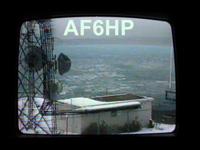
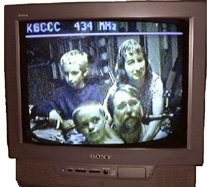
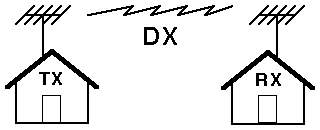 Given various transmitter power levels and antenna gains this app note will tell you.
Given various transmitter power levels and antenna gains this app note will tell you. 
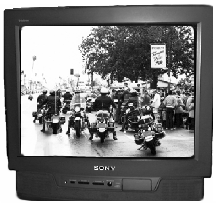
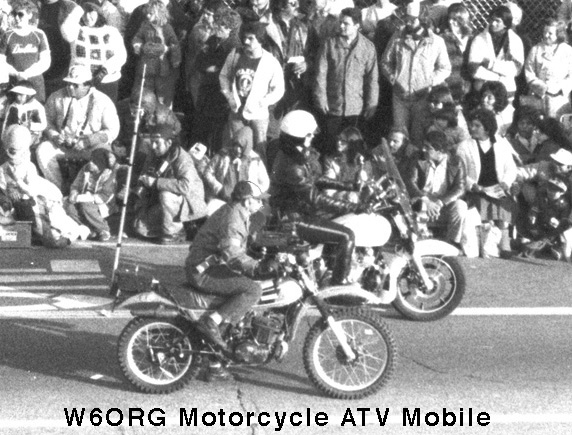 For short distances transmitting portable back to an Emergency Communications Van we suggest the Videolynx
For short distances transmitting portable back to an Emergency Communications Van we suggest the Videolynx 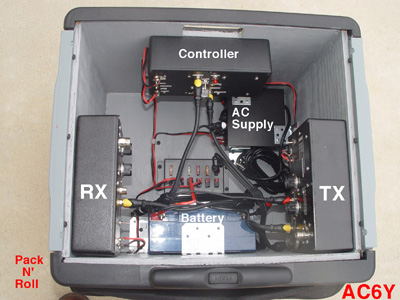
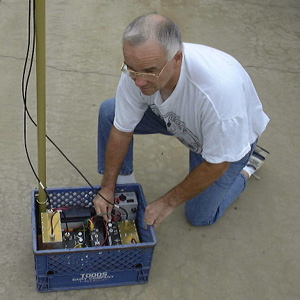 Portable Public Service ATV
Portable Public Service ATV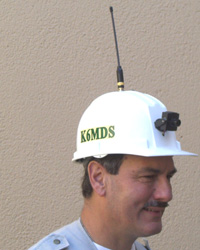
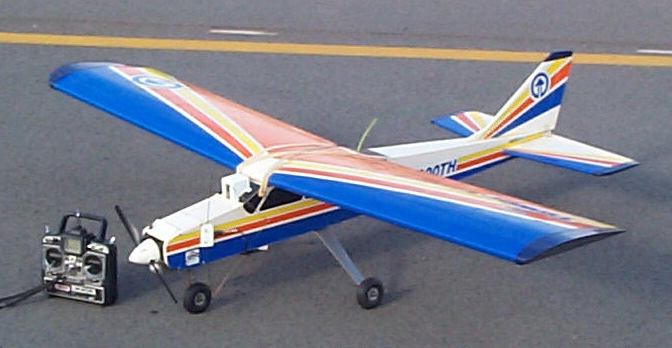
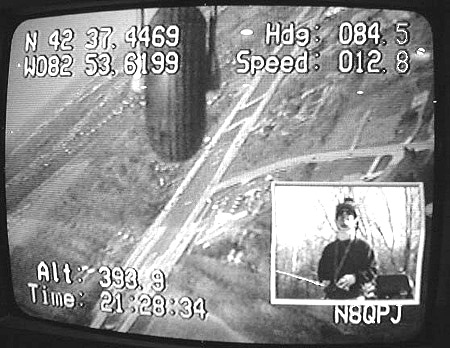
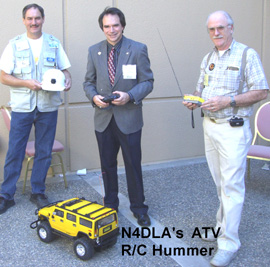
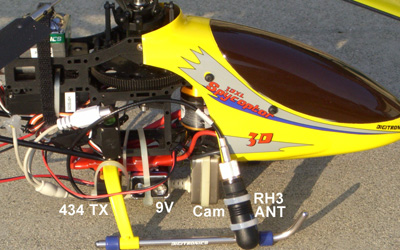

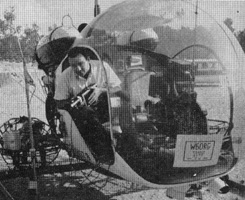
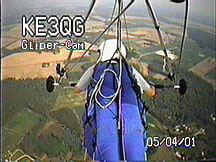 ATV in Aircraft -
ATV in Aircraft - 